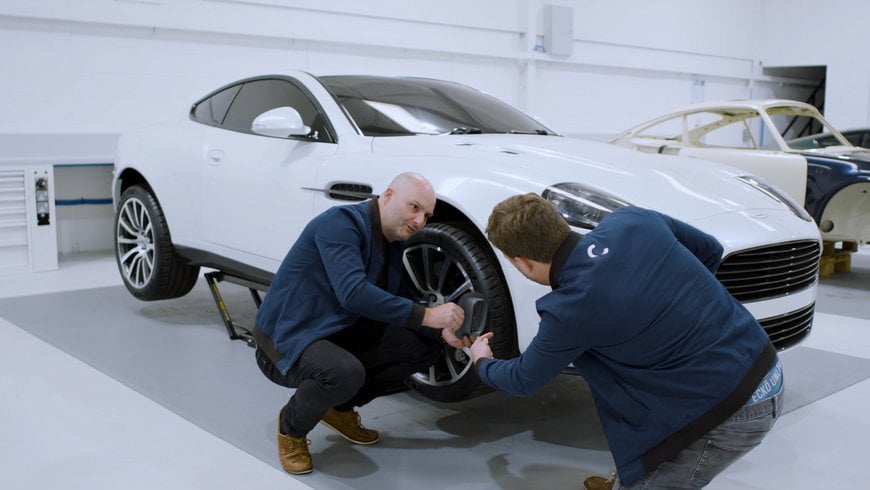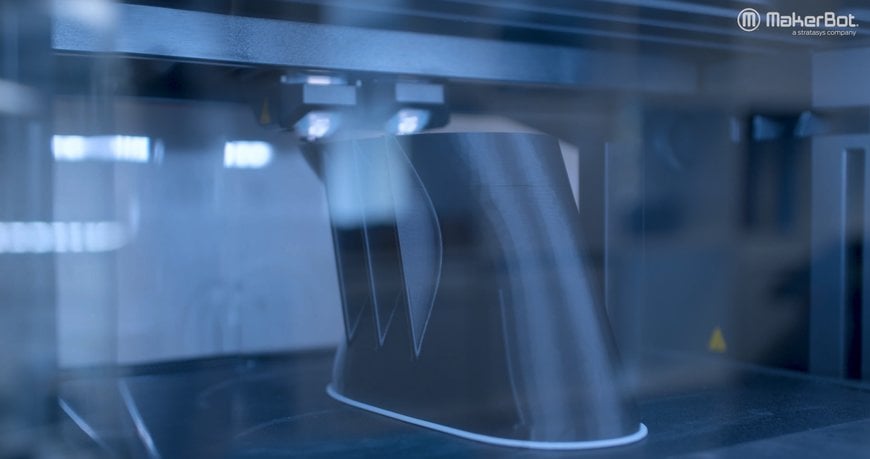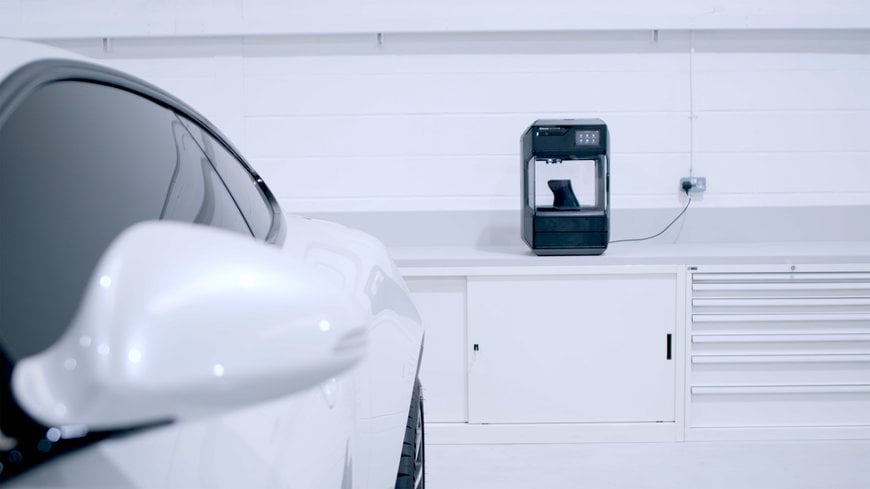www.magazine-industry-usa.com
28
'21
Written on Modified on
MakerBot METHOD X 3D printer enables CALLUM to rapidly progress from prototyping to production parts with engineering-grade materials
Design and engineering business CALLUM can swiftly produce low volume, bespoke production parts in-house for its limited-edition Aston Martin CALLUM Vanquish 25, thanks to the capabilities of the MakerBot METHOD X.

Two decades after it was first penned, the Aston Martin Vanquish’s revered designer, Ian Callum CBE, has retold the model for today’s GT driver, combining performance with usability. Utilising advances in materials and technologies, including additive manufacturing, over 350 design and engineering updates have been made to create this contemporary edition, the Aston Martin CALLUM Vanquish 25.
While the iconic lines remain, the Vanquish has been refined to create a more purposeful look and give it more power from its 5.9-litre V12 engine. It sits lower and wider, with revised suspension setup for a sharper ride, while also benefiting from the latest technologies, such as 3D printed brake ducts that feed cool air to the new carbon ceramic brakes, which bring stopping power right up to date.
Throughout the design and development process of the Aston Martin CALLUM Vanquish 25, CALLUM’s design and engineering teams have been using the MakerBot METHOD X™ 3D printer to promptly produce functional prototypes for proof of concept and stringent testing. But with the materials and finish capabilities of the METHOD X, the team is able to go one step further and create production parts in-house, something that it wasn’t capable of achieving previously.
CALLUM is using METHOD X to produce the vehicle’s brake ducts, the screen mounting devices and switch gear mounting brackets, and an intricate mounting mechanism that houses a removeable Bremont watch in the dashboard.
“Additive manufacturing has come a long way in the past ten, even five, years. The resolution of such machines is much better, allowing us to create intricate products with a high standard of finish that wouldn’t have been possible before,” explains Adam Donfrancesco, engineering director at CALLUM. “Traditionally, these parts would have been machined from billet aluminium, or created via injection moulding. These methods are expensive, time-intensive and often reliant on third-party suppliers. You may be waiting some time for a small, low volume part to be produced and when it arrives it doesn’t meet our exacting requirements – when you’re working on such a prestige vehicle as an Aston Martin, and at the level of refinement we are, everything has to be absolutely precise.”
Engineering-grade materials
“There is a high level of complexity with these parts,” continues Donfrancesco. “For example, the brake ducts need to integrate with the bumper and pick up the wheel arch lining. It’s quite an iterative process to get that right. Developing a solution with the METHOD X meant that at low cost we could experiment until we were ready to create final production parts. Then, it was a seamless process to utilise the appropriate materials, upgrading to Nylon 12 Carbon Fiber, for the final production parts fitted to the vehicle.”
The ability to produce parts from engineering-grade material is key for CALLUM. “Due to its strength, stiffness and heat resistance, Nylon 12 Carbon Fiber is an ideal lightweight solution for parts such as brake ducts. At the front end of the car you have impact considerations, and these materials enable us to meet the stringent requirements of these environments. The ability to produce parts in such strong materials is one of the most impressive attributes of the METHOD X desktop machine. For its size, it really is remarkable. The technology and capabilities of the larger, more costly systems has trickled down into the more accessible and affordable desktop machines, and that’s something that’s been hugely beneficial to CALLUM.”

CALLUM’s design and engineering teams have been using the MakerBot METHOD X™ 3D printer to promptly produce functional prototypes for proof of concept and stringent testing.
Time is of the essence
CALLUM has partnered with luxury British watch manufacturer Bremont to feature a removeable mechanical pocket watch, a highlight feature that sits centrally in the dashboard of the Vanquish 25. The team wanted to make this timepiece removeable, so the vehicle owner can wear it when not using the vehicle. Again, the METHOD X proved to be the perfect solution for developing this clock mounting mechanism.
“A lot of development was required for the clock housing,” explains Donfrancesco. “We needed to create something that worked ergonomically; many iterations were developed on the METHOD X and validated in the vehicle, which we were able to progress quickly. We needed to ensure that when you’re sat in the driver’s seat that it was easy to remove – that it wasn’t uncomfortable or forced your wrist into an unusual action to remove or insert the clock. There is also a high degree of tactility to consider, too.”
The METHOD X allowed the team to experiment with this mechanism and also introduce customization cost-effectively, developing a solution that incorporates the ‘C’ from the CALLUM brand.
“One significant benefit of the METHOD X is the way that the machine builds up the material when producing complex parts,” says Donfrancesco. “It has integrated PVA support material that can be dissolved. The beauty of this being that we can create more intricate parts and traditionally unsupported components, like the clock mounting mechanism. Rather than having to print extra material and then go through the difficult, time consuming and often messy process of removing this, the METHOD X automatically creates the support material that can be dissolved. This is a huge benefit for us that wouldn’t have been possible before.”
Increased efficiencies open up new levels of flexibility
The dimensional accuracy offered by the METHOD X was critical in CALLUM being able to achieve the mounting devices used to position and secure the infotainment screen in the dash. Conventionally, these intricate, low volume requirements would have required aluminium injection moulding, but CALLUM was able to save costs and time with the METHOD X.
“The METHOD X provides the level of accuracy needed to create the screen mounting devices, which also includes features for switches,” explains Donfrancesco. “Instead of the time and cost of developing tooling, we were able to create these intricate parts ourselves.
“Overall, our costs for both the development cycle and the production of parts have been drastically reduced. When prototyping, the cost of the filament used in the machine is so low that you can afford to make numerous iterations to perfect the solution. Then, it’s very simple and cost-effective to move to engineering-grade materials. With the filament and usage costs so low, it feels like it’s ‘free’ to try these different things,” he adds.
For a small design and engineering firm, the flexibility such a machine as the METHOD X 3D printer offers is incredibly beneficial for CALLUM. Donfrancesco adds: “There are no worries about lead times. You’re free to control your own destiny in terms of parts supply, which makes our business more efficient. For example, with small intricate parts like clips, it’s a god send. It would take significant levels of tooling, time and investment to recreate what we’re now easily able to achieve on the METHOD X.”

Having the MakerBot METHOD X™ in-house has opened new possibilities for design and production capability for the CALLUM team
Industrial-grade additive manufacturing more accessible
Having this in-house design and production capability is something that has opened new possibilities for the CALLUM team. “With our engineering team up and running on the system, they’ve been keen to try different things, to push ourselves, think outside of the box and really exploit new possibilities within design and production,” adds Donfrancesco. “Our METHOD X isn’t on the workshop floor, it’s based in our office so our design and engineering teams have easy access to experiment with industrial-grade capabilities. The user interface on the METHOD X is exceptionally good and intuitive too. I think we’re still just scratching the surface of what we can achieve with this machine and it’s an extremely exciting prospect to have this as part of our offering and toolkit as we approach future projects.”
Donfrancesco is a supporter of the benefits that additive manufacturing can bring to businesses of all sizes: “Whatever the level of your business, I’d encourage investment in additive manufacturing. Industrial-grade capabilities are now much more accessible to businesses of all sizes – the METHOD X is a prime example of that. Once you dip your toe in the water and understand how it works, you discover all these new possibilities – you get out what you put in,” he concludes.
www.makerbot.com

